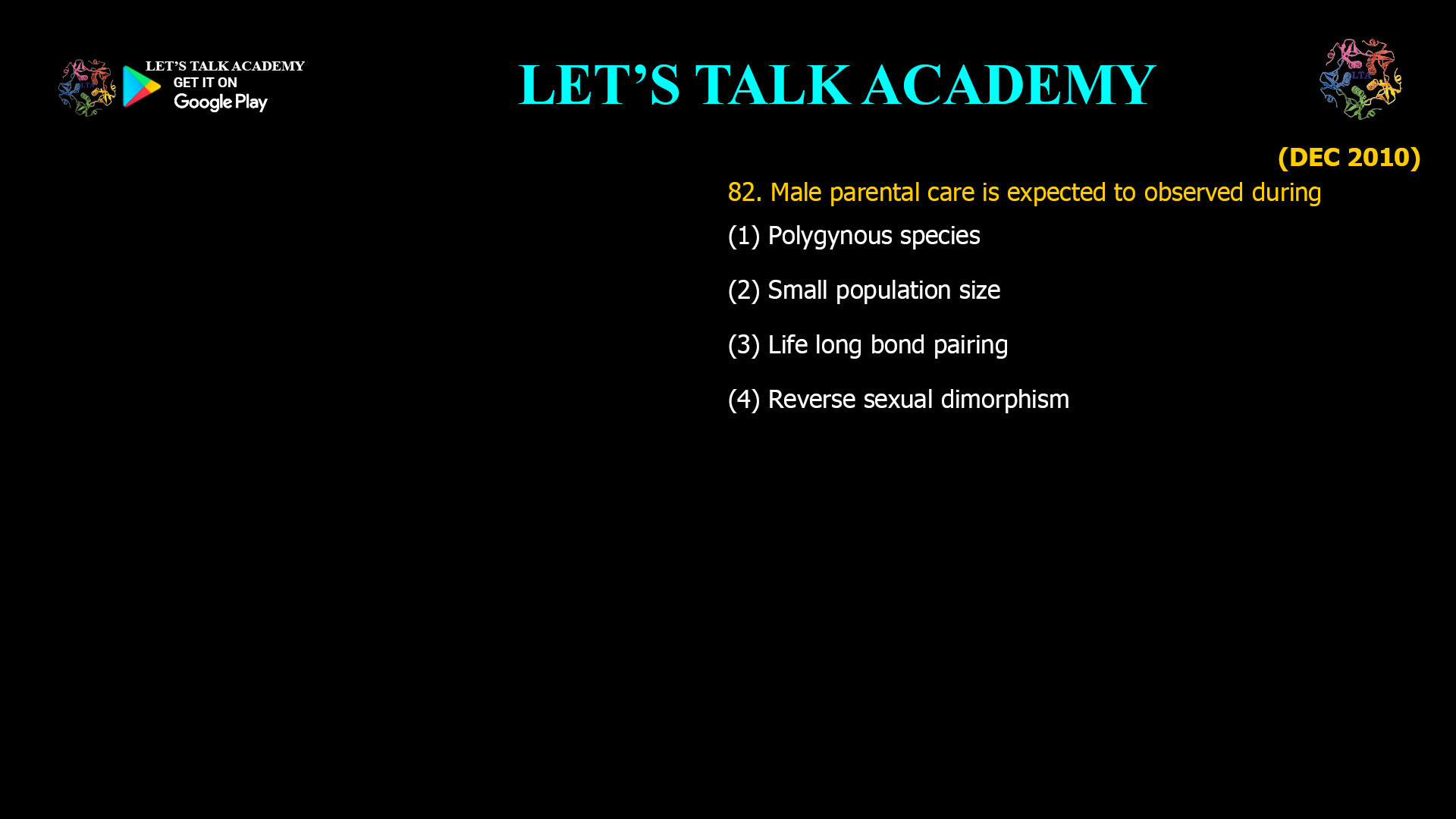82. Male parental care is expected to observed during
(1) Polygynous species
(2) Small population size
(3) Life long bond pairing
(4) Reverse sexual dimorphism
The Evolutionary Puzzle of Male Parental Care
Male parental care involves a male investing time, energy, and resources into the survival and well-being of his offspring. This can include activities such as guarding eggs, feeding young, or protecting the family from predators. The evolution of male care is influenced by several factors, including mating systems, certainty of paternity, and the benefits to both offspring and females.
Why Lifelong Pair Bonds Promote Male Parental Care
Among the various social and reproductive systems in animals, lifelong pair bonding (monogamy) stands out as the scenario where male parental care is most likely to evolve and be maintained.
Key Reasons:
-
High Paternity Certainty: In monogamous or lifelong pair-bonded species, males are much more certain that the offspring they are caring for are their own. This reduces the risk of investing in unrelated young and increases the evolutionary payoff for paternal care.
-
Shared Investment: Lifelong pair bonds often involve both parents contributing to offspring care, maximizing the survival and success of their young. This biparental care is especially common in birds and some mammals.
-
Energetic Benefits: Male care can lighten the reproductive load on females, allowing them to recover faster and potentially increase their reproductive output over time.
Scientific Evidence
Studies across mammals, birds, fish, and amphibians consistently show that male parental care is closely associated with monogamy and lifelong pair bonds. In these systems, males are more likely to invest in care behaviors that directly benefit their own reproductive success and the survival of their offspring.
Why Not Polygynous Species?
In polygynous species, where a single male mates with multiple females, male parental care is rare. The main reason is low paternity certainty—males have less assurance that the young are theirs, and their reproductive success is maximized by seeking additional mating opportunities rather than investing in care.
What About Small Population Size or Reversed Sexual Dimorphism?
-
Small Population Size: While small populations may influence social structure, it is not a primary driver for the evolution of male parental care.
-
Reversed Sexual Dimorphism: This is more closely related to role reversals in mating and foraging, but not a direct cause of male parental care. In some cases, such as in certain bird species, reversed dimorphism and male care co-occur, but the underlying cause is often the mating system and parental investment strategies.
Examples from Nature
-
Songbirds: Many songbirds form lifelong pair bonds, and both parents share in feeding and protecting the chicks.
-
Wolves: Wolf pairs are monogamous, and both male and female participate in raising pups.
-
Seahorses: In some fish like seahorses, males even carry and birth the young, a unique form of paternal care.
Evolutionary Benefits
-
Increased Offspring Survival: With both parents investing, the chances of young surviving to adulthood are higher.
-
Enhanced Female Fecundity: When males help with care, females can recover and reproduce again sooner, increasing the pair’s overall reproductive success.
Conclusion
Male parental care is most commonly observed in species with lifelong pair bonds or monogamous mating systems. These social structures provide the paternity certainty and cooperative environment necessary for males to invest in their offspring, leading to higher survival rates and evolutionary success. Understanding this connection helps explain the diversity of family life in the animal world and highlights the intricate balance between mating strategies and parental investment.



